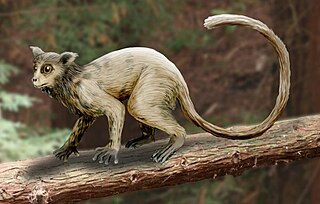Related Research Articles

Primates are a diverse order of mammals. They are divided into the strepsirrhines, which include the lemurs, galagos, and lorisids, and the haplorhines, which include the tarsiers and the simians. Primates arose 85–55 million years ago first from small terrestrial mammals, which adapted to living in the trees of tropical forests: many primate characteristics represent adaptations to life in this challenging environment, including large brains, visual acuity, color vision, a shoulder girdle allowing a large degree of movement in the shoulder joint, and dexterous hands. Primates range in size from Madame Berthe's mouse lemur, which weighs 30 g (1 oz), to the eastern gorilla, weighing over 200 kg (440 lb). There are 376–524 species of living primates, depending on which classification is used. New primate species continue to be discovered: over 25 species were described in the 2000s, 36 in the 2010s, and six in the 2020s.

New World monkeys are the five families of primates that are found in the tropical regions of Mexico, Central and South America: Callitrichidae, Cebidae, Aotidae, Pitheciidae, and Atelidae. The five families are ranked together as the Ceboidea, the only extant superfamily in the parvorder Platyrrhini.

Haplorhini, the haplorhines or the "dry-nosed" primates is a suborder of primates containing the tarsiers and the simians, as sister of the Strepsirrhini ("moist-nosed"). The name is sometimes spelled Haplorrhini. The simians include catarrhines, and the platyrrhines.

Tarsiiformes are a group of primates that once ranged across Europe, northern Africa, Asia, and North America, but whose extant species are all found in the islands of Southeast Asia. Tarsiers are the only living members of the infraorder; other members of Tarsiidae include the extinct Tarsius eocaenus from the Eocene, and Tarsius thailandicus from the Miocene. Two extinct genera, Xanthorhysis and Afrotarsius, are considered to be close relatives of the living tarsiers, and are generally classified within Tarsiiformes, with the former grouped within family Tarsiidae, and the latter listed as incertae sedis (undefined). Omomyids are generally considered to be extinct relatives, or even ancestors, of the living tarsiers, and are often classified within Tarsiiformes.

Lemuriformes is the sole extant infraorder of primate that falls under the suborder Strepsirrhini. It includes the lemurs of Madagascar, as well as the galagos and lorisids of Africa and Asia, although a popular alternative taxonomy places the lorisoids in their own infraorder, Lorisiformes.

The simians, anthropoids, or higher primates are an infraorder of primates containing all animals traditionally called monkeys and apes. More precisely, they consist of the parvorders Platyrrhini and Catarrhini, the latter of which consists of the family Cercopithecidae and the superfamily Hominoidea.

Aegyptopithecus is an early fossil catarrhine that predates the divergence between hominoids (apes) and cercopithecids. It is known from a single species, Aegyptopithecus zeuxis, which lived around 38-29.5 million years ago in the early part of the Oligocene epoch. It likely resembled modern-day New World monkeys, and was about the same size as a modern howler monkey, which is about 56 to 92 cm long. Aegyptopithecus fossils have been found in the Jebel Qatrani Formation of modern-day Egypt. Aegyptopithecus is believed to be a stem-catarrhine, a crucial link between Eocene and Miocene fossils.

Eosimias is a genus of early primates, first discovered and identified in 1999 from fossils collected in the Shanghuang fissure-fillings of Liyang, the southern city of Jiangsu Province, China. It is a part of the family Eosimiidae, and includes three known species: Eosimias sinensis, Eosimias centennicus, and Eosimias dawsonae. It provides us with a glimpse of a primate skeleton similar to that of the common ancestor of the Haplorhini. The name Eosimias is designed to mean "dawn monkey", from Greek eos "dawn" and Latin simius "monkey".

Monkey is a common name that may refer to most mammals of the infraorder Simiiformes, also known as the simians. Traditionally, all animals in the group now known as simians are counted as monkeys except the apes, thus monkeys constitute an incomplete paraphyletic grouping; however, in the broader sense based on cladistics, apes (Hominoidea) are also included, making the terms monkeys and simians synonyms in regard to their scope.

Mary R. Dawson was a vertebrate paleontologist and curator emeritus at the Carnegie Museum of Natural History in Pittsburgh, Pennsylvania.

Necrolemur is a small bodied omomyid with body mass estimations ranging from 114 grams to 346 grams. Necrolemur’s teeth feature broad basins and blunt cusps, suggesting their diet consisted of mostly soft fruit, though examination of microwear patterns suggests that populations from lower latitudes also consumed insects and gums. While they do not sport a true tooth comb like modern lemurs, microwear patterns on their lower incisors suggest they engaged in fur grooming behaviors. Like tarsiers, Necrolemur had large, front-facing, close set eyes and were likely nocturnal. Analysis of cranial and postcranial fossils by paleontologists suggest members of the family Omomyidae, including the genus Necrolemur, possessed highly specialized adaptations for leaping.
Shoshonius is an extinct genus of omomyid primate that lived during the Eocene. Specimens identified as Shoshonius have been found exclusively in central Wyoming and the genus currently includes two species, Shoshonius cooperi, described by Granger in 1910, and Shoshonius bowni, described by Honey in 1990.

Eosimiidae is the possible family of extinct primates believed to be the earliest simians.
Altiatlasius is an extinct genus of mammal, which may have been the oldest known primate, dating to the Late Paleocene from Morocco. The only species, Altiatlasius koulchii, was described in 1990.

Darwinius is a genus within the infraorder Adapiformes, a group of basal strepsirrhine primates from the middle Eocene epoch. Its only known species, Darwinius masillae, lived approximately 47 million years ago based on dating of the fossil site.
Ganlea is a fossil primate from central Myanmar, formerly known as Burma. Its age is about 38 million years, living during the late Eocene epoch. Ganlea belongs to the group of anthropoids, and is in the family Amphipithecidae. It is older than any other known anthropoid from Africa, and is the second oldest known from Asia. Its remains consist of teeth and jawbones belonging to 10 to 15 individuals found near the city of Bagan in the central part of the country.
Maboko Island is a small island lying in the Winam Gulf of Lake Victoria, in Nyanza Province of western Kenya. It is about 1.8 km long by 1 km wide. It is an important Middle Miocene paleontological site with fossiliferous deposits that were discovered in the 1930s. The age of the deposits is estimated to be 15 to 16 million years, and they are especially important for the abundance of primate fossils they contain.

The evolutionary history of the primates can be traced back 57-90 million years. One of the oldest known primate-like mammal species, Plesiadapis, came from North America; another, Archicebus, came from China. Other similar basal primates were widespread in Eurasia and Africa during the tropical conditions of the Paleocene and Eocene. Purgatorius is the genus of the four extinct species believed to be the earliest example of a primate or a proto-primate, a primatomorph precursor to the Plesiadapiformes, dating to as old as 66 million years ago.
The Amphipithecidae were simian primates that lived in Late Eocene and Early Oligocene. Fossils have been found in Myanmar, Thailand, and Pakistan. The limited fossil evidence is consistent with, but not exclusive to, arboreal quadrupedalism. In other words, the species may have moved about in trees on four legs, but not with regular leaping as seen in later simians.

"Missing link" is a hypothetical or recently-discovered transitional fossil. It is often used in popular science and in the media for any new transitional form. The term originated to describe the hypothetical intermediate form in the evolutionary series of anthropoid ancestors to anatomically modern humans (hominization). The term was influenced by the pre-Darwinian evolutionary theory of the Great Chain of Being and the now-outdated notion (orthogenesis) that simple organisms are more primitive than complex organisms.
References
- 1 2 3 4 Science
- ↑ "CMNH Vertebrate Paleontology: K. Christopher Beard". Archived from the original on 2010-07-03. Retrieved 2010-04-22.
- ↑ "People | Department of Geology and Environmental Science | University of Pittsburgh | University of Pittsburgh".
- ↑ "K. Christopher Beard | Department of Ecology & Evolutionary Biology". eeb.ku.edu. Archived from the original on 2014-05-22.
- ↑ "Newly discovered fossils from China shed light on common ancestry of monkeys, apes and humans". Archived from the original on 2010-04-10. Retrieved 2010-04-22.
- ↑ "NASA - No Bones About It: NASA Analyzes Prehistoric Predator from the Past".